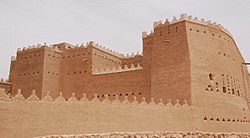Diriyah (الدِرْعِيّة, ad-Dir‘īyah) is a town in the Nejd region of Saudi Arabia, on the northwestern outskirts of Riyadh.
Understand
[edit]
Diriyah is the ancestral home of the Saud dynasty and served as their capital from 1727 until 1818, when what was then the Emirate of Diriyah was defeated by Ottoman forces. The inhabitants fled to what is today Riyadh, leaving their old mud-brick homes in ruins.
In the 2010s, the at-Turaif District comprising the ruins was named a ![]() UNESCO World Heritage Site, and the Saudi state commenced a large effort to restore the area and turn it into both a tourist attraction and the self-proclaimed "Beverly Hills of Riyadh".
UNESCO World Heritage Site, and the Saudi state commenced a large effort to restore the area and turn it into both a tourist attraction and the self-proclaimed "Beverly Hills of Riyadh".
Tourism information
[edit]Get in
[edit]Diriyah is about 15 km away from KAFD in northern Riyadh. There is no public transport, so you'll need to drive or catch a taxi/Uber/Careem.
Access to the historical district at At-Turaif or Bujairi Terrace requires a Diriyah Access Pass. Pricing is dynamic: as of 2024, entry is free until 5 PM but costs 50 riyals afterwards. The cost of the pass can be redeemed as credit when dining at any restaurant in the area.
Get around
[edit]See
[edit]At-Turaif District
[edit]- 1 Salwa Palace (قصر سلوى). The residence and first home of the Saʿūdī Amirs and Imāms during the Emirate of Diriyah. It is considered the largest palace on the site, rising four stories high. It is composed of five main parts built at different consecutive periods of time. It was probably finished by Saud ibn Abdul Aziz ibn Muhammad ibn Saud, who was Imam from 1803 to 1814. It is now a museum.

- Sa'ad bin Saʿūd Palace popularly known as the Palace of Saad (قصر سعد بن سعود). One of the largest palaces on the site, it is famous for its courtyard, which was used as a stable. The palace was restored in the late 1980s and is several stories high. Sa'd ibn Sā'ud was the son of Imām Abd Allāh bin Saʿūd āl Sāʿūd (d. 1819) and played a prominent role in the battle for the city in 1818.

- The Guest House and At-Turaif Bath House a traditional building consisting of a number of small courtyards surrounded by rooms. The Bath House is famous for its different architectural styles and shows how the building was waterproofed by using different plasters. Both the Guest and Bath Houses were supplied with water from a well in the wadi.
- Imām Muḥammad bin Saʿūd Mosque, a mosque built first during the reign of Imām Mohammad bin Saud (1687–1765), perhaps replacing an earlier structure. Imām Abdulaziz bin Muhammad Al Saud was assassinated here while leading Asr prayer in November 1803. The building fell into ruins after the invasion of 1818 and the disappearance of the first Saudi state; only part of the structure on the eastern side survived to the 1970s and is still preserved. A small mosque was built on the south-west corner of the site some time in the first half of 20th century. Subsequently the location was excavated to reveal the large hypostyle mosque of the 18th century. The modern mosque was replaced with a traditional building as part of the development under the UNESCO heritage programme.
- Al-Bujairi (البجيري), one of the districts of the city, directly adjacent to Qasr Salwa on the opposite side of the wadi. It was the religious centre of the historical settlement, surrounded by palm trees. The chief building was mosque of the Shaykh Muḥammad bin ʿAbd al-Wahāb (محمد بن عبد الوهاب), now rebuilt and set in the al-Bujairi Heritage Park. Shaykh Mohammad ibn Abdulwahab used to give lessons about his reformed movement of Islam in this mosque. It became a centre for religious education. Students used to travel to it from all parts of the Arabian Peninsula.
- Ghasiba (غصيبة), a walled historic site and on the edge of Wadi Hanifah, is to the north of old Dir'iyyah and is thought to date back to the 17th century CE.
Other notable buildings
[edit]- Qasr al-'Ujā (قصر العوجا) is a large Saudi royal palace erected adjacent to the old city on the south bank of Wadi Hanifa.
- The mosque of al-Zawiharah (مسجد الظويهرة) is located in the al-Bujairi Heritage Park and is an old traditional building, restored and reopened in 2014. It is notable for the underground chamber (khālwa), a feature encountered in the older mosques in the Najd region.
- The mosque of al-Sarikhah (مسجد السريحة) is a modern building made in the traditional central Arabian style. It is located on the west side of the al-Bujairi Heritage Park.
- The mosque of Nakhil al-'Dhibah (مسجد نخيل العذيبة) is located a short distance to the west of the old city, in the farm of Sultan Bin Salman. It is built in the traditional central Arabian style.
Museums
[edit]A number of the palaces in the old city have been restored and are used as museums.
- Museum of Bygone Days (متحف السنين الماضية) is located north of al-Bujairi and houses a collection reflecting everyday life in central Arabia in the early and middle twentieth century.
Do
[edit]Buy
[edit]The Diriyah Square shopping mall, under construction as of 2025, will house 400 shops.
Eat
[edit]Bujairi Terrace hosts 20 restaurants and cafes. Access requires either a Diriyah Access Pass or a confirmed reservation.
Drink
[edit]Sleep
[edit]32 hotels, including not one but two by the ultra-luxe Aman group, are in various stages of construction in and around Diriyah.
- 1 Bab Samhan. Luxury hotel by Marriott. From 2200 SAR.




